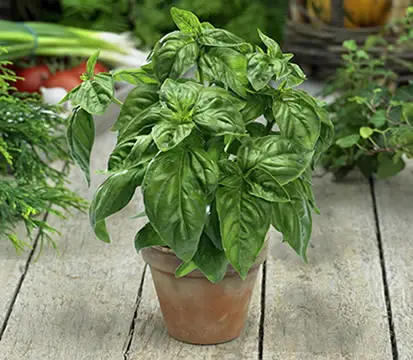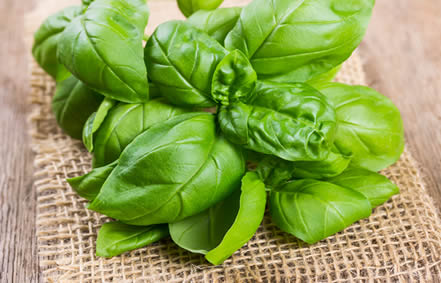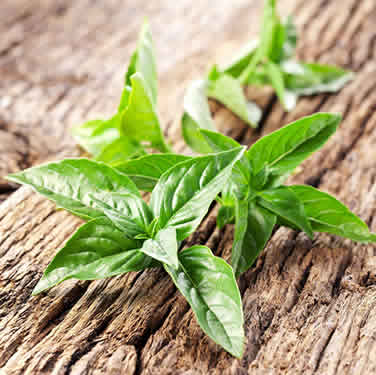Basil (Ocimum basilicum) is one of the most cherished herbs in the kitchen garden. Its unmistakable aroma, soft green leaves, and bold flavor make it a staple in everything from pesto to pasta to fresh summer salads.
While basil is easy to grow, it’s also surprisingly sensitive to poor conditions. With the right setup, though, it can thrive indoors or outdoors and reward you with flavorful leaves for months on end.
Whether you’re growing it on a sunny windowsill or planting it in your garden bed, here’s how to keep your basil vibrant, productive, and delicious.
Table of Contents
- What Makes Basil Special
- Light Requirements: Give It Full Sun
- Watering: Keep Soil Moist but Never Soggy
- Soil and Potting: Rich and Well-Draining
- Fertilizer: Feed Lightly and Consistently
- Pruning and Maintenance: Harvest Often and Early
- Best Spot in the Home
- Outdoor Basil Care
- Popular Basil Varieties
- Common Problems and Fixes
- Final Thoughts
What Makes Basil Special
Native to India, Southeast Asia, and parts of Africa, basil is an annual herb in most climates, although it grows as a perennial in tropical zones.
There are many different cultivars, including sweet basil, Thai basil, lemon basil, and purple basil—each with its own distinct scent, leaf shape, and culinary role.

This sun-loving plant grows quickly, responds well to pruning, and is happiest when harvested regularly.
Its tender leaves are packed with essential oils that are strongest right before the plant begins to flower.
Light Requirements: Give It Full Sun
Basil needs at least 6 hours of direct sunlight per day to grow well and develop its signature flavor.
Outdoors, place it in a sunny garden bed or container that gets full morning and early afternoon sun.
Indoors, a south-facing window is ideal.
If you don’t have enough natural light, use a full-spectrum grow light to supplement and prevent leggy growth.
Without enough light, basil becomes pale, thin, and loses its strong flavor.
Watering: Keep Soil Moist but Never Soggy
Basil likes moisture, but soggy roots will quickly cause it to decline.
Water when the top inch of soil feels dry, and make sure the pot or garden bed has good drainage.
In hot weather or bright sun, basil may need watering every 1–2 days, especially in containers.

Indoors, check soil frequently and avoid letting the plant dry out completely.
Water at the base of the plant to keep the leaves dry and reduce the chance of fungal issues.
Soil and Potting: Rich and Well-Draining
Basil grows best in loamy, nutrient-rich soil with excellent drainage.
The ideal pH range is 6.0 to 7.5.
For pots, use a high-quality potting mix amended with:
-
2 parts potting soil
-
1 part compost or worm castings
-
1 part perlite or coarse sand
In garden beds, enrich the soil with aged compost or organic matter before planting.
Avoid heavy clay soils or compacted dirt that retains too much water.
Fertilizer: Feed Lightly and Consistently
Basil benefits from regular feeding during its growing season.
Apply a balanced, organic fertilizer every 2–4 weeks with an NPK ratio of around 10-10-10 like this one, or 5-5-5 like this one.
Liquid seaweed, fish emulsion, or compost tea are excellent gentle options that won’t overpower the plant.
Don’t overfeed—too much fertilizer can reduce flavor and make the plant grow more leaves than it can support.
Pruning and Maintenance: Harvest Often and Early
Frequent harvesting keeps basil full, bushy, and productive.
-
Begin pruning when the plant has at least 6–8 leaves.
-
Cut above a set of leaves to encourage branching.
-
Remove flower buds as soon as they appear to prevent flavor loss.

If your basil gets leggy, prune it back by one-third and move it to a brighter location.
In the garden, pinch regularly to prevent bolting and encourage dense growth.
Consider using healthy cuttings for growing new plants as outlined in the article How To Propagate Basil (Ocimum Basilicum) Successfully.
Best Spot in the Home
Indoors, basil does best in a warm, sunny kitchen window, south-facing windowsill, or under a grow light on a countertop.
The ideal spot will get bright, direct light and good airflow, but no drafts or extreme temperature changes.
It’s best kept near where you’ll use it—convenience encourages frequent harvesting, which only makes the plant grow better.
Outdoor Basil Care
Basil grows beautifully outdoors in spring and summer in zones 4–11 as an annual.
-
Plant after the last frost when nights are consistently above 50°F (10°C).
-
Space plants 12–18 inches apart for airflow and light.
-
Keep soil moist and mulch around the base to retain moisture.
-
Harvest leaves frequently and remove flowers to extend the growing season.
In warm climates, basil can be grown outdoors nearly year-round or reseeded every few months.
To extend your harvest into fall, transplant potted basil indoors before the first frost.
Popular Basil Varieties
There are many cultivars of basil, each with its own aroma and shape:
Sweet Basil (Ocimum basilicum) – The most common culinary type, with broad, aromatic green leaves. Great for pesto and sauces.
Thai Basil – Spicier, with narrow leaves and purple stems. Holds up well in cooking and is common in Southeast Asian dishes.
Lemon Basil – Bright citrus scent and flavor. Perfect for teas and seafood dishes.
Genovese Basil – A cultivar of sweet basil with a slightly stronger flavor and larger leaves. A favorite for Italian cooking.
Purple Basil – Dark leaves and a mild flavor. Adds color to salads and herb mixes.
Greek Basil – Compact and dense with tiny leaves. Great for containers and garnishes.
Most types of basil can be propagated from cuttings and grown easily in pots or garden beds.
Common Problems and Fixes
Yellowing leaves
Usually caused by overwatering or poor drainage.
Let soil dry slightly and avoid wetting the leaves.
Leggy stems
Lack of light or irregular pruning.
Move to a brighter spot and trim back by one-third.
Bolting (flowering too early)
Triggered by heat or age.
Remove flower buds and prune frequently.

Pests (aphids, spider mites, whiteflies)
Rinse with water or apply neem oil or insecticidal soap if needed.
Powdery mildew or leaf spots
Improve airflow, water at the base, and avoid overcrowding.
Final Thoughts
Basil is an incredibly rewarding herb that gives back more the more you use it.
With enough light, consistent moisture, and regular harvesting, it’ll provide flavorful leaves all season long—indoors or out.
Whether you’re making homemade pesto, garnishing your favorite dish, or just enjoying the scent in your kitchen, basil is a must-have in any herb garden.

